Definition of residential and non-residential premises
According to the law, residential premises are intended only for the residence of citizens (Housing Code, Art. 17, Part 1). Residential premises are a residential building (part of it), apartment (part of it), room (Housing Code Art. 16 Part 1). Note that the “part” of a house and apartment refers to living rooms associated with auxiliary premises that are used to meet the household needs of citizens (Housing Code Art. 16, Part 2 and Part 3).
In this case, a premises is recognized as residential if it is isolated, belongs to real estate and complies with the standards of suitability (technical, sanitary) for permanent residence of citizens (Housing Code Art. 15 Part 2).
As for non-residential premises, according to the “Rules for the provision of public utilities” (approved by Government Decree No. 354 of 05/06/2011), in apartment buildings they are the premises noted in the design (technical) documentation for a high-rise building, or in its electronic passport, as not related to residential premises and not included in the common property of owners of multi-storey housing.
In the information letter of the Supreme Arbitration Court of the Russian Federation No. 53 dated June 1, 2000, non-residential premises are defined as a real estate object that is different from the building (structure) in which it is located, but is inextricably linked with it.
How to transfer an apartment or private house to a non-residential property?
Converting a residential property to a commercial property is not difficult. However, when carrying out this procedure, it is necessary to comply with the requirements of current legislation.
The changes introduced to the Housing Code of the Russian Federation by Law No. 116-FZ dated May 29, 2019 and which entered into force on June 9, 2021, introduced some features into the transfer process that, on the one hand, complicated the procedure for changing the status of housing, and on the other hand made it more transparent for owners of apartments in the residential building in which the “transferred” apartment will be located.
What kind of housing is permissible to register as a non-residential fund?
The usual minimum area of housing transferred to non-residential stock is a “studio” or one-room apartment. Moreover, the living space being redesigned cannot be located above residential premises, only above commercial ones. Considering the requirement for a separate entrance, apartments no higher than the second floor can be made non-residential, ideally premises on the ground or first floor.
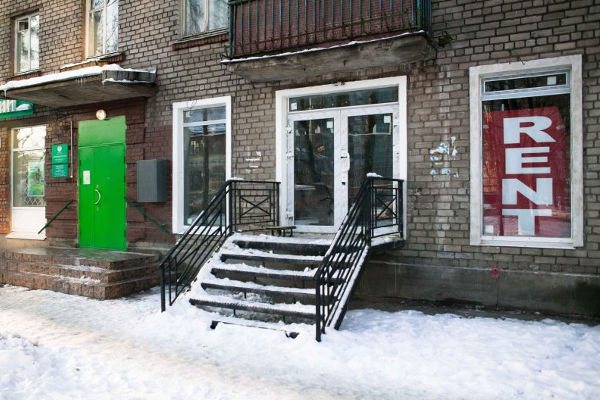
of one room into non-residential
from the composition of the apartment is not directly prohibited by law, but in practice this is difficult to achieve. According to the Housing Code (Article 22), the premises being transferred require a separate entrance, the presence of communications (water, heating, sewerage, electricity) separate from other premises of the apartment and documentary evidence of the owner’s rights.
Let us note that the configuration redevelopment of an apartment, as well as a room in a residential high-rise building, is prohibited by law (Housing Code, Article 25, Part 2).
Transfer of a mortgaged apartment
into non-residential real estate is unacceptable without the approval of the mortgagee - the creditor bank. It is prohibited to dispose of an apartment that is under a mortgage encumbrance without the permission of the creditor (Civil Code Art. 346 Part 2).
But even if the bank finds it beneficial to transfer the mortgaged housing to a commercial fund, a legislative barrier will arise - Article 22 of the Housing Code directly states that the transfer of living space to a non-residential fund in the presence of encumbrances (mortgage collateral) is impossible. Therefore, for a mortgaged apartment, the only option for re-registration into non-residential premises is a judicial procedure.

Change the status of an individual private house
from residential to non-residential is possible. However, not only the building is taken into account here, but also the land plot under the building. On plots for individual housing construction, it is permissible to build exclusively residential buildings and auxiliary courtyard buildings, and not commercial real estate.
To register a private house as non-residential, you will also need to change the intended purpose of the land plot, or part of it (Law No. 172-FZ “On Land Transfer”) by submitting an application to the local administration.
Directly redesign part of the premises of a residential building
The law does not allow for commercial use. Living in one part of the house and using the second for a store or office allows for one option - allocating part of the residential building in kind. To do this, you will need to divide the house in two, organize an independent entrance to each part and conduct separate communications.
It will also be necessary to change the purpose of the land plot under the “commercial” part of the house, which will become non-residential.
To redesign a residential high-rise building
for a non-residential building as a whole, it is necessary to purchase all residential premises of the owners (apartments). At the same time, the preparation of technical documentation on engineering communications (clauses 20 and 21, part 2, article 2 of the law No. 384-FZ “Technical Regulations”) is not required - the building was originally equipped with them.
Conditions for re-registration of housing into non-residential stock
The legislation of the Russian Federation reflects the rules defining the circumstances of the transfer of residential property to the sphere of commercial use. Most of the conditions are established by the Housing Code (Chapter 3):
- The permissible location of the apartment being converted as part of a multi-storey building is 1-3 floors. The premises of the second and third floors are subject to transfer to non-residential property if there are non-residential real estate objects underneath them;
- The room being redesigned must have a separate entrance or allow independent entry in the future. Depending on the type of commercial use in the future, non-residential premises may require an emergency exit (SP 112.13330.2011);
- the permissible number of registered citizens in an apartment transferred to non-residential use is zero. Registration is possible only in residential real estate (Part 3 of Article I “Rules for registration and removal of citizens of the Russian Federation...”). Those. before submitting documents for re-registration of the premises, it is necessary to reset the registration number of residents in this apartment to zero;
- a high-rise building, the apartment of which is transferred to non-residential, should not be in disrepair, require major repairs, be subject to demolition or reconstruction (Article 10, Chapter II of the Regulations “On recognizing premises as residential”);
- re-registration of an apartment as a non-residential property is not possible if the premises are under any encumbrance (seizure), including a mortgage and a loan agreement. Transfer of encumbered housing to non-residential premises is permitted only after the termination of the pledge;
- the presence of illegal alterations in an apartment being converted into non-residential is not permitted by law;
- conversion of an apartment into a non-residential building in a building of cultural and historical value will require permission from the authorized government agency (Article 47.3 of the Law No. 73-FZ “on cultural heritage sites”);
- Converting residential space to commercial use is impossible if there is no connection to engineering and communication systems.
Finally, the transfer of an apartment to non-residential housing is prohibited by law if this living space belongs to social housing (Housing Code Art. 22, Part 3.1.).
Is it possible to do this?
Practicing lawyers note: making an apartment or private house uninhabited is as easy as shelling pears only in theory. In practice, the procedure may not be feasible. For example, if it is impossible to arrange a separate entrance to an office apartment.
Against this background, transferring a private house to non-residential stock looks like a simple matter. There are not many residents who will have to “beg” for adjacent territory. If the house is two or three floors, but belongs to one person, then all floors can be converted into offices.
In addition, there is almost always a small area near the house, which is also very useful. For example, for a parking lot.
The following video explains whether it is possible to transfer your private house or apartment on the ground floor to non-residential premises, and how to turn them into, for example, a cafe:
The procedure for transferring residential premises to non-residential premises
To obtain official “non-residential” status in relation to recent housing (apartments, houses), the owner will need to collect a fairly large set of documents from various authorities. The prepared documents are reviewed by the Property Management Department and its interdepartmental commission.
Stage zero: neighbors' opinion
Since preparing documents is a costly process - it will cost several hundred thousand rubles - the owner should first “test” the mood of the neighbors in the high-rise building.
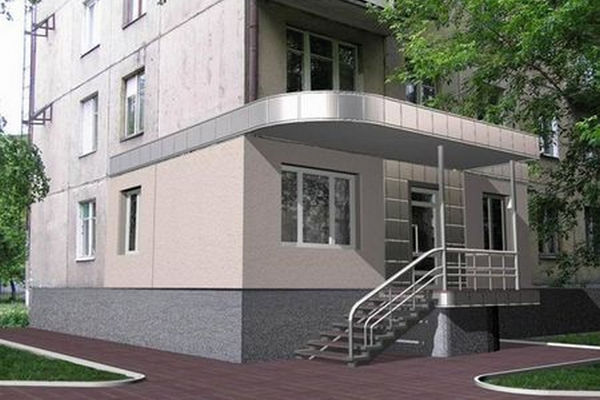
According to the Housing Code, the consent (written) of the owners of apartments adjacent to the premises being transferred is required (Article 23, Part 2.2.). The consent of all apartment owners of a high-rise building is also necessary, since the subsequent arrangement of a separate entrance with a staircase extension to a non-residential premises will require a reduction in the local area (Article 40 Part 2).
Please note that the transfer of a private house (part of a house) to a non-residential building does not require the approval of neighbors if there is no abutment between the walls of neighboring buildings.
First stage: documents from the BTI
You need to obtain a cadastral extract (floor plan), an explication and a technical passport with a technical plan for residential premises from the BTI. To order them, the applicant will need to confirm his identity and provide title documents for the property. In some regions, BTI employees also require the provision of documents substantiating ownership (donation agreement, purchase, inheritance certificate).
Stage two: ordering a project
You need to order a project and sketch for converting an apartment (house) into a non-residential premises. This requires the assistance of a licensed architect.
Third stage: coordination with the regional department of architecture
The owner sends the set of documents prepared at the early stages to the regional department of architecture to receive an approval certificate. The need for this document is approved by the administrative regulations of municipalities in the constituent entities of the Russian Federation when applying for a service for coordinating the reconstruction (redevelopment) of housing.
The prepared approval act must be signed by the fire department and SES, by energy suppliers and utility companies, and by the district administration.
Stage four: documents from the management company
It is necessary to obtain a certificate from the authority managing the high-rise building about the purpose of other premises located on the same floor as the premises being transferred to non-residential use.
The management company obtains a technical report describing the technical condition of the apartment building, indicating that it is not an emergency facility subject to demolition.
Fifth stage: protocol of consent of the owners in the neighborhood
The most difficult stage, largely depending on the location of the apartment (district). According to the Housing Code, it is impossible to do without the consent of the neighboring owners (Article 40, Part 2).
To simplify the task, it is better to raise the issue of transferring the premises to non-residential stock at a meeting of apartment owners organized by the management company - as one of the topics on the meeting agenda. According to the Housing Code, if the meeting is attended by more than 50% of the homeowners from the apartment building and if 2/3 of those present approve the construction of a separate entrance, then the decision will be considered legal (Article 45 Part 3 and Article 46 Part 1).
Stage six: refurbishment of the apartment
Having received the recorded consent of the legally permitted number of owners of residential premises in a high-rise building, it is necessary to start the process of redevelopment of the premises according to the architectural project prepared at the second stage.
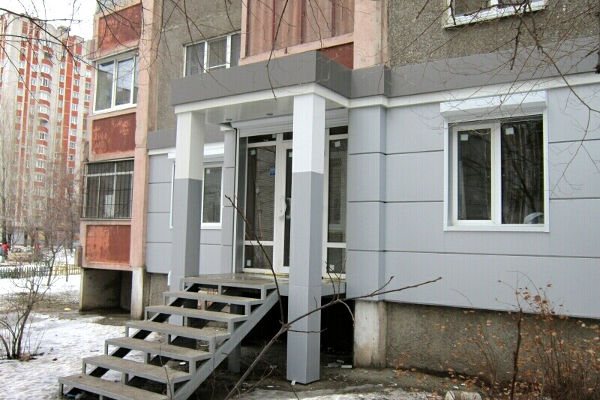
Having completed the refurbishment of housing, it is necessary to call the housing commission of the State Housing Inspectorate to accept the result of the redevelopment according to the act (Housing Code Art. 28).
Seventh stage: permission to transfer
Having collected all the documents from the early stages and completed the redevelopment of the premises into a non-residential format, you need to request permission from the Property Management Department to transfer the apartment to a non-residential format.
Please note: the application must indicate the reason for re-registration of a residential apartment into a non-residential property! The application is accompanied by documents confirming the identity of the applicant and all documentation collected previously (legal documents are required!). If the applicant is a legal entity, then the constituent documents (copies) are submitted with the application.
The response of the interdepartmental commission, formed when the applicant applies to the Property Management Department, is issued after a maximum of 45 days (Housing Code Art. 23, Part 4). In case of refusal, the reason must be given. Usually they refuse due to incomplete documents, or non-compliance with the procedure for preparing the apartment for transfer (Housing Code Art. 24).
If refused, the applicant has the right to go to court to appeal if he considers the refusal to be unfounded. The owner also has the right to correct the comments of the interdepartmental commission and apply for re-registration as a non-residential property again. The number of applications is not limited by law.
If the transfer of the premises to the non-residential stock is approved, the owner remains to complete the re-registration process.
Eighth stage: payment of the difference in cost
Having permission from the Property Management Department, you need to submit an application to the BTI to determine the cost of transferring the premises to non-residential use. The application is accompanied by all previously collected documents and the protocol of the interdepartmental commission for consent to the re-registration of the living space.
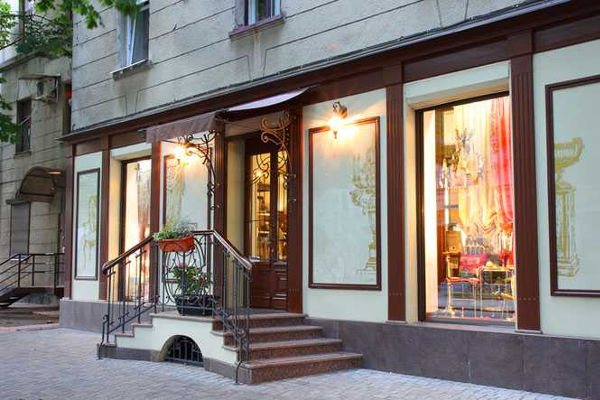
The cost of the transfer will be determined by members of the commission of the department of privatization and housing stock management; their decision is documented in a protocol. The commission’s task is to establish the difference in the cost of a residential apartment and the non-residential premises formed from it.
The Privatization Commission takes into account numerous parameters, from the location and condition of an apartment building to assessing the benefits of commercial use. An important factor will be the intended purpose of the premises being converted into non-residential ones. As a rule, an apartment in non-residential status is more expensive.
By decision of the commission, the owner (applicant) is issued a protocol with the difference in the cost of the premises in residential and non-residential status. The applicant must pay the difference amount to a specified account through any bank.
Ninth stage: registration of re-registration
It is necessary to submit an application for transfer to a non-residential property and a set of documents to Rosreestr - through a local branch or MFC. Attached are an identification document, protocols from the Property Management Department and the BTI, a receipt for the paid fee and a cadastral passport of the apartment being re-registered. Registration of changes in the status of an apartment in Rosreestr will take 5-12 days.
How to convert commercial property into residential?
Transfer to non-residential or residential real estate is carried out practically according to the same scenario:
- Coordination of redevelopment, if required.
- Obtaining permission for redevelopment.
- Registration of a new technical passport.
- Submitting an application for transfer.
- Inspection of the premises by a commission.
- Receipt of the act and conclusion.
- Receiving a decision on transfer.
- Making changes to the Unified State Register of Real Estate.
Let's look at step by step how to convert commercial real estate into residential, the cost and documents for this procedure.
Step 1: approval of redevelopment
Redevelopment approval is required if a commercial property does not meet the requirements for residential property, but its status needs to be changed. To do this, you need to order a redevelopment project, submit it along with an application and documents for the premises to the housing department of the administration.
Step 2: obtaining permission for redevelopment
Submitted documents are considered by the administration for no more than 45 days (Article 26 of the RF Housing Code). Based on the results, a permit is issued. The owner can begin work on the premises.
Step 3: obtaining a new registration certificate
Upon completion of the work, a new technical passport is issued taking into account the changes made. You can order it from a cadastral engineer.
Step 4: submitting an application to transfer non-residential premises to residential premises
To transfer commercial real estate to residential, you need to draw up an application and submit the following documents with it to the interdepartmental commission:
- Owner's passport.
- Notarial consents of all owners, if the premises are in shared or joint ownership.
- Cadastral passport.
- Technical passport.
- Minutes of the general meeting of owners, if the premises are located in an apartment building.
- Floor plan of an apartment building.
- Extract from the Unified State Register of Real Estate.
Contents and sample application
There is no standardized application form, and it is usually completed when submitted on site. What information does it contain:
- To whom the application is sent: name, address.
- From whom: Full name, address, passport details, telephone number.
- Information about the property: type, cadastral number, address.
- Request to transfer non-residential premises to residential premises.
- Description of submitted documents.
- Date of compilation and signature.
Sample application
Consultation on document preparation
Step 5: inspection of the premises by the commission
Having received the application, the commission must, within 45 calendar days, check the premises for compliance with established requirements and draw up a report. The commission may include employees of the housing committee of the administration, the urban planning committee, the Ministry of Emergency Situations and other institutions.
The procedure is carried out taking into account the provisions of Art. 23 of the Housing Code of the Russian Federation and Decree of the Government of the Russian Federation of January 28, 2006 No. 47.
Step 6: receiving the inspection report and conclusion
The inspection report is drawn up in triplicate, and a conclusion is drawn up on its basis. The body that made the decision to transfer the status of the premises must send a conclusion and order to the applicant within 5 days.
Contents and sample of the inspection report
The inspection report is drawn up by the commission in the prescribed form after inspecting the premises. What information does it contain:
- Date and number.
- FULL NAME. chairman and members of the commission.
- Who appointed the commission?
- FULL NAME. invited experts.
- FULL NAME. the applicant owner.
- Address of the object being examined.
- Description of the condition of the premises and supporting structures.
- Information about non-compliance with requirements (if any).
- Evaluation of the results of the inspection.
- Conclusion of the commission.
- Attached documents.
- Signatures of the chairman and members of the commission.
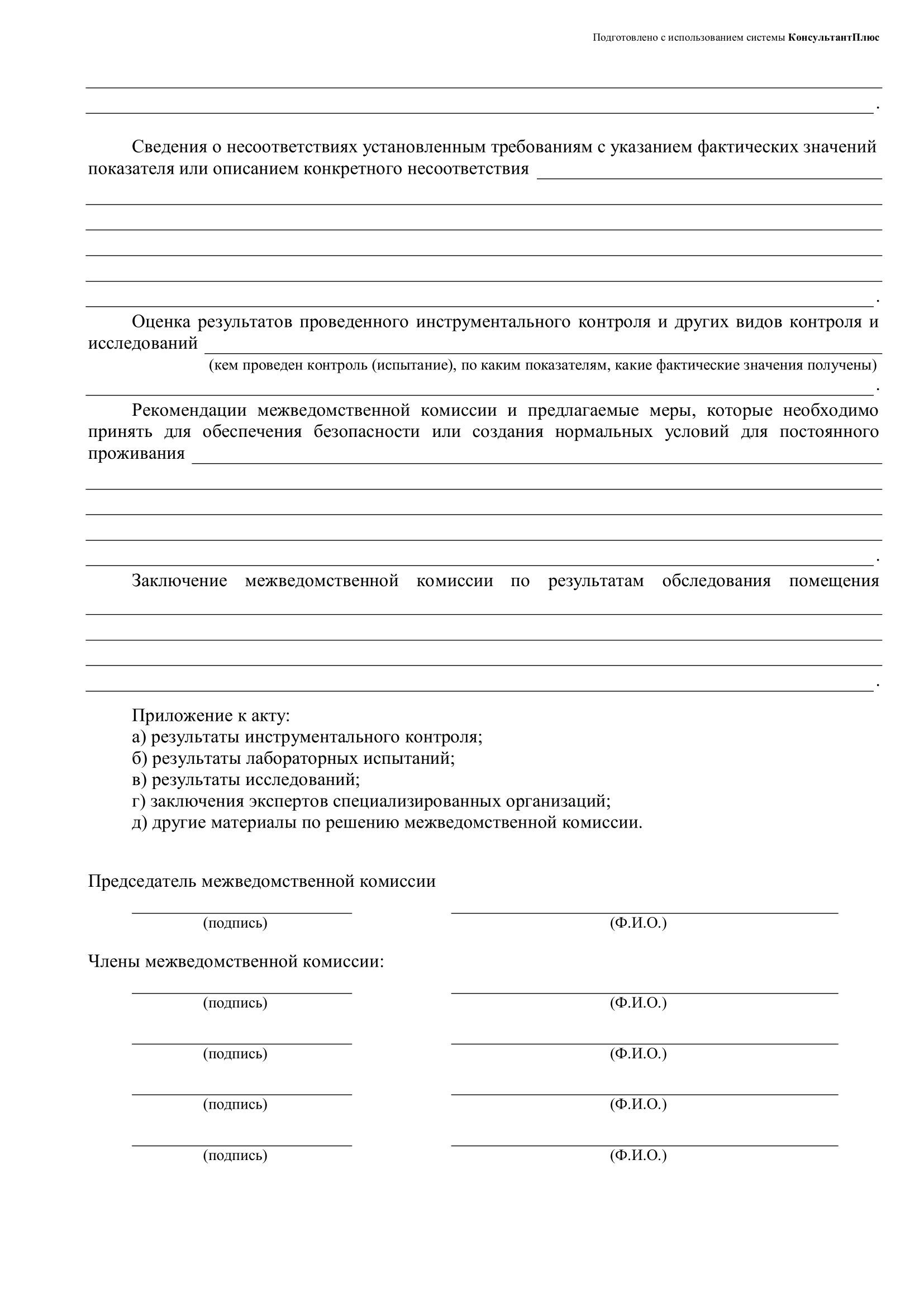
Sample act
Consultation on document preparation
Contents and sample conclusion
The conclusion contains the same information as in the act, but the wording “the commission adopted a conclusion on the compliance of the premises with the established requirements” or “on non-compliance” is indicated.
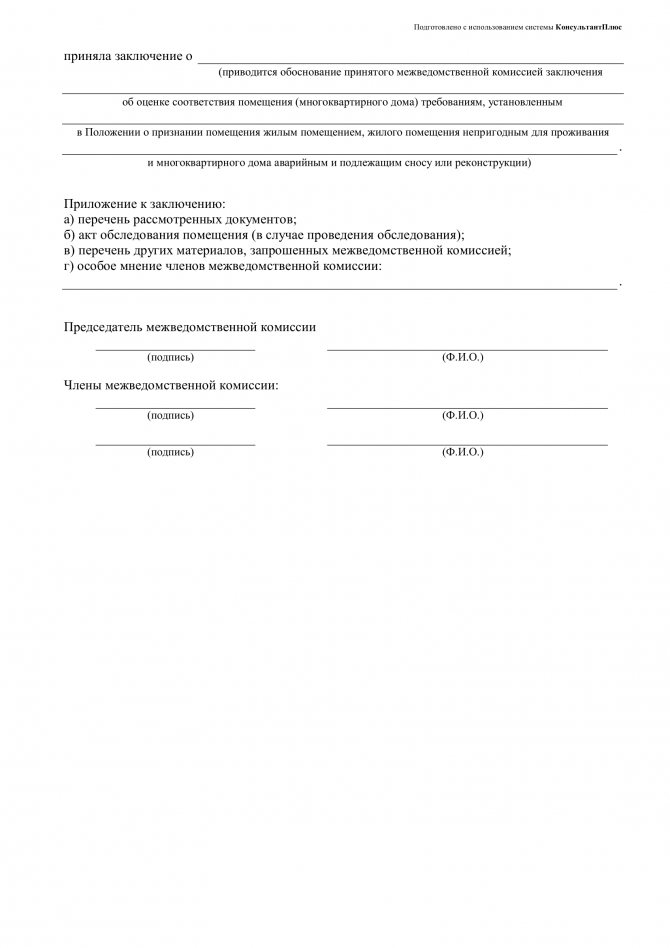
Sample conclusion
Consultation on document preparation
Step 7: Getting a Solution
Based on the conclusion, the administration makes a decision to transfer the property from non-residential to residential status. It is sent to the owner within 5 days after acceptance.
Step 8: making changes to the Unified State Register
An order to change the status of an object is sent by the administration to Rosreestr, but the owner has the right to make changes independently by submitting documents directly or through the MFC.
Responsibility for using real estate for other purposes
If the owner of a residential premises carries out business in it without re-registration as a non-residential property, he will be fined by the State Housing Inspectorate (Administrative Code Articles 7.21 and 7.22).
In addition, neighbors in an apartment building, as well as other interested parties, have the right to demand the sale of residential premises at a public auction if the owner violates the rules for the operation and use of the apartment. It is enough for them to contact the local administration, after which the authorities will issue an order to the owner to eliminate violations in the use of real estate (Housing Code Art. 29 and Civil Code Art. 293).
The amount of work involved in converting residential real estate to non-residential property is significant, but the prospects for commercial use of the premises justify the time and money spent on the transfer.
To avoid wasting time and money, contact the specialists of our association.











